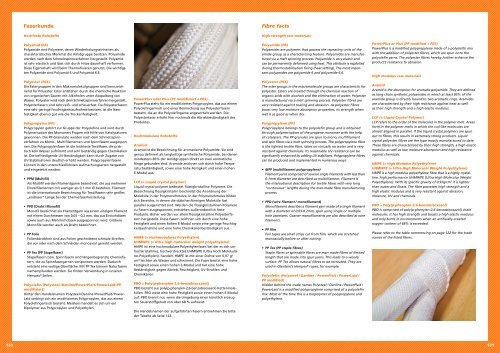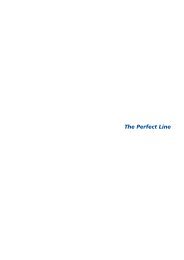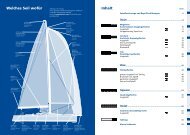GeoMarine - Gleistein
GeoMarine - Gleistein
GeoMarine - Gleistein
Sie wollen auch ein ePaper? Erhöhen Sie die Reichweite Ihrer Titel.
YUMPU macht aus Druck-PDFs automatisch weboptimierte ePaper, die Google liebt.
Faserkunde<br />
Hochfeste Rohstoffe<br />
Polyamid (PA)<br />
Polyamide sind Polymere, deren Wiederholungseinheiten als<br />
cha rak teristisches Merkmal die Amidgruppe besitzen. Polyamide<br />
werden nach dem Schmelzspinnverfahren hergestellt. Polyamid<br />
ist sehr elastisch und lässt sich durch Hitze dauerhaft verformen.<br />
Diese Eigenschaft wird beim Thermofixieren genutzt. Die wichtigsten<br />
Polyamide sind Polyamid 6 und Polyamid 6.6.<br />
Polyester (PES)<br />
Die Estergruppen in den Makromolekülgruppen sind kennzeichnend<br />
für Polyester. Ester entstehen durch die chemische Reaktion<br />
von organischen Säuren mit Alkoholen unter Abspaltung von<br />
Wasser. Polyester wird nach dem Schmelzspinnverfahren hergestellt.<br />
Polyesterfasern sind sehr reiß und scheuerfest. Da Polyesterfasern<br />
eine sehr geringe Feuchtigkeitsaufnahme besitzen, ist die Nassfestigkeit<br />
ebenso gut wie die Trockenfestigkeit.<br />
Polypropylen (PP)<br />
Polypropylen gehört zur Gruppe der Polyolefine und wird durch<br />
Polymerisation des Monomers Propen mit Hilfe von Katalysatoren<br />
gewonnen. Die PPGranulate werden nach dem Schmelzspinnverfahren<br />
zu Mono, Multifilamenten und Spinnfasern ausgesponnen.<br />
Die Polypropylenfaser ist die leichteste Textilfaser, die prak<br />
tisch kein Wasser aufnimmt und sehr beständig gegen Chemikalien<br />
ist. Die befriedigende UVBeständigkeit kann durch Zugabe von<br />
UVStabilisatoren deutlich erhöht werden. Polypropylenfasern<br />
können in den unterschiedlichsten Aufmachungsarten hergestellt<br />
und eingesetzt werden:<br />
• PPM (Multifil)<br />
Als Multifil werden Filamentgarne bezeichnet, die aus mehreren<br />
Einzelfilamenten mit weniger als 0,1 mm Ø bestehen. Filament<br />
ist die internationale Bezeichnung für Textilfasern sehr großer,<br />
„endloser“ Länge bei der Chemiefaserherstellung.<br />
• PPD (Draht /Monofil)<br />
Monofil bezeichnet ein Filamentgarn aus einem einzigen Filament<br />
mit einem Durchmesser von 0,03 – 0,2 mm, das aus Einlochdüsen<br />
sowie auch aus Mehrlochdüsen ausgesponnen wird. Gröbere<br />
Monofile werden auch als Draht bezeichnet.<br />
• PP Folie<br />
Folienbändchen sind aus Folien geschnittene schmale Streifen,<br />
die vor oder nach dem Schneiden monoaxial gereckt werden.<br />
• PP Tex (PP Stapelfaser)<br />
Stapelfasern bzw. Spinnfasern sind längenbegrenzte Chemiefasern,<br />
die zu Spinnfasergarnen versponnen werden. Dadurch<br />
entsteht eine wollige Oberfläche. Mit PP Tex können Naturfasern<br />
nachempfunden werden. Sie finden Verwendung in unseren<br />
Hempex ® Seilen.<br />
Polyolefin (Polysteel /Danline/PowerPlait / PowerLaid /PP<br />
modifiziert)<br />
Hinter den Handelsnamen Polysteel / Danline / PowerPlait / Power<br />
Laid verbirgt sich ein modifiziertes Polypropylen, das aus einem<br />
Polyolefingemisch besteht. Meistens handelt es sich um ein<br />
Bipolymer aus Polypropylen und Polyethylen.<br />
PowerPlus oder Plus (PP modifiziert + PES)<br />
PowerPlus steht für ein modifiziertes Polypropylen, das aus einem<br />
Polyolefingemisch und einer Beimischung aus Polyesterfasern<br />
besteht, die an die Polyolefingarne angewirbelt werden. Die<br />
Poly esterfaser erhöht hier nochmals die Abriebbeständigkeit des<br />
Produktes.<br />
Hochmodulare Rohstoffe<br />
Aramid<br />
Aramid ist die Bezeichnung für aromatische Polyamide. Sie sind<br />
genau definiert als langkettige synthetische Polyamide, bei denen<br />
mindestens 85% der Amidgruppen direkt an zwei aromatische<br />
Ringe gebunden sind. Aramide zeichnen sich durch hohe Temperaturbeständigkeit,<br />
sowie eine hohe Festigkeit und einen hohen<br />
EModul aus.<br />
LCP (= Liquid crystal polymer)<br />
Liquid crystal polymer bedeutet flüssigkristalline Polymere. Die<br />
Bezeichnung flüssigkristallin beschreibt die Anordnung der<br />
Moleküle in der Polymerschmelze. In der Polymerschmelze bilden<br />
sich Bereiche, in denen die stäbchenförmigen Moleküle fast<br />
parallel ausgerichtet sind. Werden die flüssigkristallinen Polymere<br />
zu Fasern ausgesponnen, entstehen außerordentlich feste<br />
Produkte. Bisher werden vor allem flüssigkristalline Polyesterfasern<br />
hergestellt. Diese Fasern zeichnen sich durch eine hohe<br />
Festigkeit und einen hohen EModul sowie eine geringe Feuchtigkeitsaufnahme<br />
und eine hohe Chemikalienbeständigkeit aus.<br />
HMPE (= Hochmodulares Polyethylen)<br />
UHMWPE (= Ultra high molecular weight polyethylene)<br />
HMPE ist eine hochmodulare Polyethylenfaser, bei der es sich um<br />
hochkristallines, hochverstrecktes UHMWPE (Ultra Hoch Molekuläres<br />
Polyethylen). handelt. HMPE ist mit einer Dichte von 0,97 g/<br />
cm³ leichter als Wasser und schwimmt. Die Faser besitzt eine hohe<br />
Festigkeit sowie einen hohen EModul und hat eine hohe<br />
Beständigkeit gegen Abrieb, Feuchtigkeit, UVStrahlen und<br />
Chemikalien.<br />
PBO = Poly(p-phenylen-2,6-benzobisoxazol)<br />
PBO besteht aus poly(pphenylen2,6benzobisoxazol) Kettenmolekülen.<br />
PBO weist eine hohe Festigkeit sowie einen hohen EModul<br />
auf. PBO brennt nur, wenn die Umgebung einen künstlich erzeugten<br />
Sauerstoffgehalt von über 68 % aufweist.<br />
Die Handelsnamen der aufgeführten Fasern entnehmen Sie bitte<br />
der Tabelle ab Seite 122.<br />
Fibre facts<br />
High strength raw materials<br />
Polyamide (PA)<br />
Polyamides are polymers that possess the repeating units of the<br />
amide group as a characterising feature. Polyamides are manufactured<br />
via a melt spinning process. Polyamide is very elastic and<br />
can be permanently deformed using heat. This attribute is exploited<br />
during thermostabilisation fixing (heat setting). The most important<br />
polyamides are polyamide 6 and polyamide 6.6.<br />
Polyester (PES)<br />
The ester groups in the macromolecule groups are characteristic for<br />
polyester. Esters are created through the chemical reaction of<br />
organic acids with alcohols and the elimination of water. Polyester<br />
is manufactured via a melt spinning process. Polyester fibres are<br />
very resistant against tearing and abrasion. As polyester fibres<br />
boast very low moisture absorption properties, its strength when<br />
wet is as good as when dry.<br />
Polypropylene (PP)<br />
Polypropylene belongs to the polyolefin group and is obtained<br />
through polymerisation of the propene monomer with the help<br />
of catalysers. The PP granules are spun to mono, multifilament<br />
and spin fibres via a melt spinning process. The polypropylene fibre<br />
is the lightest textile fibre, takes on virtually no water and is very<br />
resistant against chemicals. Its reasonable UV resistance can be<br />
significantly enhanced by adding UV stabilisers. Polypropylene fibres<br />
can be produced and implemented in numerous ways:<br />
• MFP (multifilament polypropylene)<br />
Filament yarns comprised of several single filaments with less than<br />
0.1mm diameter are described as multifilament. Filament is<br />
the international description for textile fibres with very long<br />
“continuous” lengths during the man-made fibre manufacturing<br />
process.<br />
• PPD (wire filament / monofilament)<br />
Monofilament describes a filament yarn made of a single filament<br />
with a diameter of 0.03-0.2mm, spun using single or multiple<br />
hole atomisers. Coarser monofilaments are also described as wire<br />
filaments.<br />
• PP film<br />
Foil tapes are small strips cut from film, which are stretched<br />
monoaxially before or after cutting.<br />
• PP Tex (PP staple fibres)<br />
Staple fibres or spinnable fibres are man-made fibres of limited<br />
length that are made into spun yarns. This leads to a woolly<br />
surface. PP Tex allows natural fibres to be recreated. They are<br />
used in <strong>Gleistein</strong>’s Hempex ® ropes, for example.<br />
Polyolefin (Polysteel / Danline / PowerPlait / PowerLaid /<br />
PP modified)<br />
Hidden behind the trade names Polysteel / Danline / PowerPlait /<br />
PowerLaid is a modified polypropylene comprised of a polyolefin<br />
mix. Most of the time this is a biopolymer of polypropylene and<br />
polyethylene.<br />
PowerPlus or Plus (PP modified + PES)<br />
PowerPlus is a modified polypropylene made of a polyolefin mix<br />
with the addition of polyester fibres, which are spun onto the<br />
polyolefin yarns. The polyester fibres hereby further enhance the<br />
product’s resistance to abrasion.<br />
High modulus raw materials<br />
Aramid<br />
Aramid is the description for aromatic polyamide. They are defined<br />
as long-chain synthetic polyamides in which at least 85% of the<br />
aramide group is directly bound to two aromatic rings. Aramides<br />
are characterised by their high resistance against heat as well<br />
as their high strength and a high elastic modulus.<br />
LCP (= Liquid Crystal Polymer)<br />
LCP refers to the order of the molecules in the polymer melt. Areas<br />
form in the polymer melts in which the rod-like molecules are<br />
almost aligned in parallel. If the liquid crystal polymers are spun<br />
out to fibres, this results in extremely strong products. Liquid<br />
crystal polyester fibres are the type mostly manufactured to date.<br />
These fibres are characterised by their high strength, a high elastic<br />
modulus as well as low moisture absorption and high resistance<br />
against chemicals.<br />
HMPE (= High Modulus Polyethylene)<br />
UHMWPE (= Ultra-High Molecular Weight Polyethylene)<br />
HMPE is a high modulus polyethylene fibre that is a highly crystalline,<br />
high performance UHMWPE (Ultra-High Molecular Weight<br />
Polyethylene). With its specific gravity of 0.97g/cm 3 it is lighter<br />
than water and floats. The fibre possesses high strength and a<br />
high elastic modulus and is very resistant against abrasion,<br />
moisture, UV and chemicals.<br />
PBO = Poly(p-phenylen-2,6-benzobisoxazol)<br />
PBO is comprised of poly(p-phenylen-2,6-benzobisoxazol) chain<br />
molecules. It has high strength and boasts a high elastic modulus<br />
and only burns in environments when an artificially-created<br />
oxygen content of 68% is exceeded.<br />
Please refer to the table commencing on page 122 for the trade<br />
names of the listed fibres.<br />
120 121





